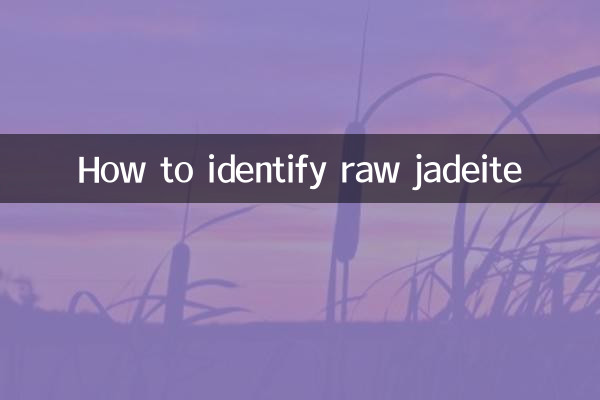How to identify raw jadeite: analysis of hot topics on the Internet
In the past 10 days, the identification of rough jadeite has become a hot topic among collectors and jewelry enthusiasts. As the jadeite market continues to heat up, more and more people are paying attention to how to identify the authenticity and quality of raw jadeite. This article will combine recent hot topics to provide you with a detailed analysis of the identification methods of jadeite rough, and provide structured data to help you quickly grasp the core points.
1. Basic methods for identification of jadeite rough stones

The identification of jadeite rough mainly relies on observation, touch and instrumental testing. Here are some of the most common methods:
1.Observe color and shine: The color distribution of natural jadeite is natural and the luster is soft, while the color of artificially processed jadeite is often too bright or unevenly distributed.
2.Check texture and structure: The texture of natural jadeite is fine and the structure is tight, while the texture of imitation or inferior jadeite is rough and the structure is loose.
3.Use a magnifying glass or microscope: By magnifying the surface and internal structure of the original jade stone, you can more clearly judge its authenticity.
4.Density test: Natural jade has a higher density and feels heavy, while imitations are usually lighter.
2. Recent hot topics: Misunderstandings in the identification of rough jadeite stones
Recently, many netizens have shared on social media the misunderstandings they encountered during the appraisal process of raw jadeite. Here are a few common misunderstandings:
1.Superstitious "Old Pit" Jadeite: Not all Laokeng jadeite is of high quality, Xinkeng jadeite also has high-quality varieties.
2.Overreliance on certificates: Although the certificate is an important reference, it cannot be completely relied on and must be combined with physical observation.
3.Ignore origin factors: Jadeite raw stones from different origins have different characteristics, and a comprehensive judgment needs to be made based on the characteristics of the origin.
3. Key indicators for identification of raw jadeite stones
The following are the key indicators and explanations for the identification of rough jade stones:
| index | illustrate |
|---|---|
| color | Natural jade has a natural color and is evenly distributed; artificial jade has a color that is too bright or unevenly distributed. |
| transparency | High-quality jade has high transparency and strong light penetration; low-quality jade has low transparency and weak light penetration. |
| texture | Natural jadeite has fine texture and tight structure; imitation has rough texture and loose structure. |
| density | Natural jadeite has high density and feels heavy to the touch; imitation jade has low density and feels light to the touch. |
| hardness | Natural jade has high hardness and is not easy to scratch; imitations have low hardness and are easy to scratch. |
4. Practical skills for identifying rough jadeite stones
Based on recent popular content, we have summarized several practical jadeite rough identification tips:
1.More comparisons: Observe more jadeite rough stones from different origins and accumulate experience.
2.With the help of tools: Use magnifying glass, microscope and other tools to assist observation.
3.Ask the experts: If you encounter a situation that is difficult to judge, consult professionals promptly.
4.Pay attention to market dynamics: Understand the latest jade market conditions and counterfeiting methods to avoid being deceived.
5. Conclusion
Jadeite rough identification is a complex knowledge that requires long-term study and practice. I hope that through the analysis of this article, you can have a deeper understanding of the identification of rough jadeite. Recent hot topics also remind us that when collecting raw jade stones, we must remain rational and avoid blindly following the trend. Only by mastering scientific identification methods can we be able to navigate the jade market with ease.

check the details

check the details